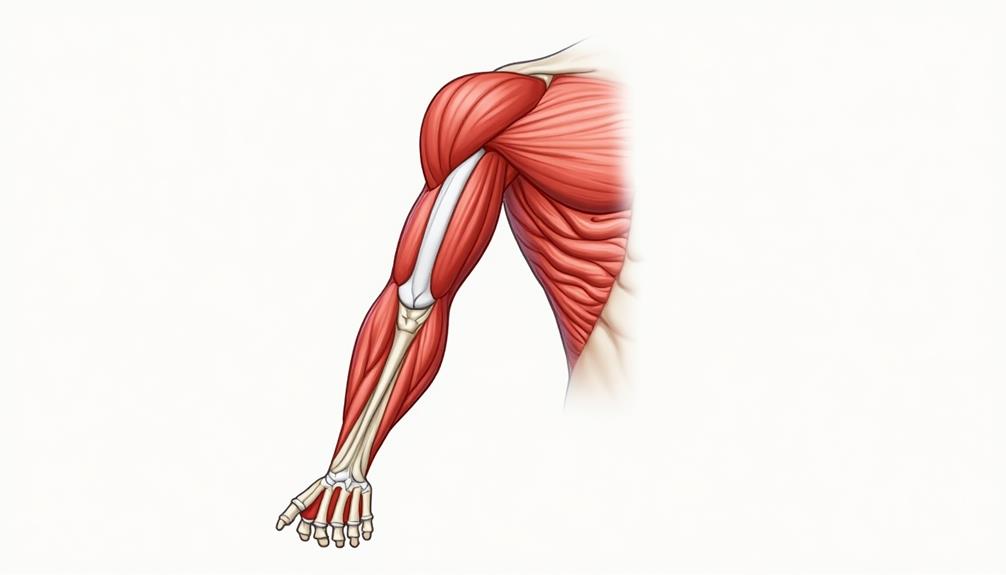To master bicep growth with resistance training, start by understanding bicep anatomy. Focus on key exercises like bicep curls, hammer curls, and chin-ups, as these effectively target your muscles. Maintain proper form to enhance performance and minimize injury, like keeping your elbows close and using a full range of motion. Aim for 2-3 bicep workouts each week, focusing on 10-20 sets for best stimulation. Don't forget the importance of nutrition and recovery strategies for muscle growth. By following these guidelines, you'll set yourself up for success—there's much more to explore on this journey!
Core Insights
- Incorporate a variety of exercises like curls, hammer curls, and chin-ups to stimulate different muscle fibers for balanced development.
- Maintain proper form by engaging your core, keeping elbows close, and avoiding swinging or momentum during lifts.
- Implement progressive overload by gradually increasing weights or reps to continuously challenge your biceps for growth.
- Schedule 2-3 bicep workouts per week, focusing on 10-20 sets for optimal muscle engagement and recovery.
- Prioritize rest days and recovery strategies to prevent injury and ensure sustained progress in bicep growth.
Understanding Bicep Anatomy

To effectively target bicep growth, it's important to understand the anatomy of this muscle group. The bicep consists mainly of two heads: the long head and the short head. The long head runs along the outer arm, while the short head sits on the inner side. Both heads work together to flex the elbow and rotate the forearm. Incorporating versatile resistance training can help target both heads effectively, promoting balanced muscle development. This approach allows for a wide range of exercises that engage the biceps from various angles.
You'll also find the bicep brachii connecting to the shoulder joint, which plays a role in lifting movements. Understanding these connections helps you choose exercises that effectively engage both heads. By targeting each part of the bicep, you can create a balanced workout that promotes overall growth. Familiarizing yourself with this anatomy sets the foundation for effective training strategies.
Key Principles of Resistance Training

Resistance training relies on several pivotal principles that can optimize your bicep growth and overall strength. First, prioritize progressive overload. This means gradually increasing the weight or resistance you use. It challenges your muscles and promotes growth. Next, pay attention to your form. Proper technique ensures you're targeting the right muscles and reduces the risk of injury.
Moreover, incorporate variety into your training. Different exercises and angles keep your workouts fresh and stimulate muscle adaptation. Don't overlook recovery; rest days are essential for muscle repair and growth. Lastly, maintain consistency. Regular workouts lead to sustained progress. By applying these principles, you'll establish a solid foundation for effective resistance training, ultimately enhancing your bicep development and overall fitness journey.
Essential Bicep Exercises

While you're working on building your biceps, incorporating crucial exercises into your routine is essential for maximizing growth. Start with the classic bicep curl. Using dumbbells or a barbell, lift the weight towards your shoulders, focusing on the contraction. Next, try hammer curls. These target different muscle fibers and add variety to your workout. For added versatility and convenience, consider using resistance bands to perform these exercises, as they offer various resistance levels and are highly portable. Don't forget chin-ups; they're excellent for overall arm development, engaging your biceps effectively. Preacher curls can isolate your biceps, helping to prevent swinging and improve focus. Lastly, consider concentration curls for intense muscle engagement. By mixing these exercises, you'll create a balanced workout that promotes ideal bicep growth. Remember, consistency is key, so include these in your regular routine for the best results.
Proper Form and Technique

Mastering the right form and technique is crucial for effective bicep training. Start with your feet shoulder-width apart and engage your core. When performing curls, keep your elbows close to your sides. This minimizes unnecessary movement and isolates the biceps. Use a full range of motion—lower the weights until your arms are fully extended and curl them back up smoothly. Avoid swinging or using momentum; focus on controlled movements instead. Always maintain a neutral wrist position to prevent strain. If you're using dumbbells, align them with your arms throughout the exercise. For beginners or those recovering from injuries, lower resistance levels are ideal for toning and rehabilitation. Remember, proper breathing is key; exhale as you lift and inhale as you lower. With these techniques, you'll optimize your bicep growth and reduce the risk of injury.
Training Frequency and Volume

- Frequency: Aim for 2-3 bicep workouts per week. This allows for sufficient recovery while keeping the muscles engaged.
- Volume: Focus on 10-20 sets per week. This range is effective for stimulating growth without risking overtraining.
- Progressive Overload: Gradually increase weights or reps. This guarantees your muscles continually adapt and grow, preventing plateaus.
Importance of Nutrition

Nutrition plays an important role in bicep growth, as what you consume directly impacts your muscle development and recovery. To maximize your gains, focus on a balanced diet rich in protein, carbohydrates, and healthy fats. Protein is necessary for muscle repair, so aim for sources like chicken, fish, beans, and legumes.
Carbohydrates are essential for fueling your workouts, providing the energy you need to push through those tough resistance sessions. Healthy fats, found in avocados, nuts, and olive oil, support hormone production, which is crucial for muscle growth.
Hydration also matters; drink plenty of water to keep your body functioning at its best. By prioritizing nutrition, you'll set a solid foundation for your bicep growth journey and enhance your overall training results.
Recovery Strategies for Growth

Effective recovery strategies are necessary for maximizing bicep growth after resistance training. Without proper recovery, you risk stalling your progress and increasing the chance of injury. Here are three key strategies to help you recover effectively:
- Rest Days: Incorporate at least one to two rest days per week. This gives your muscles time to repair and grow stronger.
- Hydration: Drink plenty of water throughout the day. Staying hydrated aids muscle recovery and reduces soreness.
- Sleep: Aim for seven to nine hours of quality sleep each night. Sleep is essential for muscle recovery and hormone regulation, directly impacting growth.
Tracking Your Progress

After focusing on recovery strategies, it's time to turn your attention to tracking your progress. Monitoring your bicep growth is essential for continuous improvement. Start by keeping a workout journal. Note the exercises, sets, reps, and weights used during each session. This will help you identify patterns and make necessary adjustments.
Next, consider taking measurements. Use a tape measure to track your bicep circumference every few weeks. This gives you tangible evidence of your progress.
Finally, take progress photos. These visual reminders can be incredibly motivating.
Regularly review your data to assess what's working and what needs tweaking. Staying consistent with tracking will keep you accountable and help you achieve your bicep growth goals effectively.
Frequently Asked Questions
What Are Common Mistakes During Bicep Workouts?
During bicep workouts, you often rush through reps, neglect proper form, or use weights that're too heavy. Focusing on controlled movements, full range of motion, and balanced training can prevent these common mistakes and enhance results.
How Do Genetics Affect Bicep Growth?
Did you know about 40% of bicep size can be attributed to genetics? Your unique genetic makeup influences muscle fiber composition and growth potential, meaning some folks might gain size faster than others, despite similar training efforts.
Can Women Achieve Significant Bicep Size?
Absolutely, you can achieve significant bicep size! With consistent training, proper nutrition, and the right techniques, your biceps can grow just like anyone else's. Don't underestimate your potential; stay dedicated, and you'll see results.
What Role Does Hydration Play in Muscle Growth?
Hydration is essential for muscle growth. When you're well-hydrated, your muscles function better, recover faster, and perform at their best. Don't underestimate water's role; it helps transport nutrients, aids in muscle repair, and enhances overall workout efficiency.
How Long Does It Take to See Bicep Results?
Typically, you might notice bicep results in about 4-6 weeks with consistent training. Studies show that muscle fibers can grow by 10% in just 8 weeks. Stay dedicated, and your efforts will pay off.

